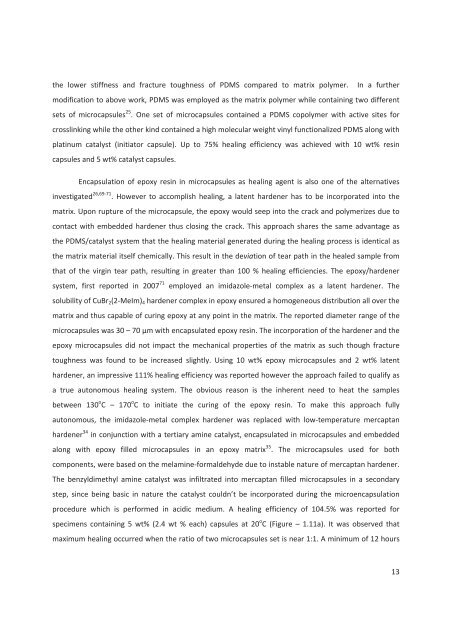4(%3)3 - Ecole nationale supérieure de chimie de Montpellier
4(%3)3 - Ecole nationale supérieure de chimie de Montpellier
4(%3)3 - Ecole nationale supérieure de chimie de Montpellier
Create successful ePaper yourself
Turn your PDF publications into a flip-book with our unique Google optimized e-Paper software.
the lower stiffness and fracture toughness of PDMS compared to matrix polymer. In a furthermodification to above work, PDMS was employed as the matrix polymer while containing two differentsets of microcapsules 25 . One set of microcapsules contained a PDMS copolymer with active sites forcrosslinking while the other kind contained a high molecular weight vinyl functionalized PDMS along withplatinum catalyst (initiator capsule). Up to 75% healing efficiency was achieved with 10 wt% resincapsules and 5 wt% catalyst capsules.Encapsulation of epoxy resin in microcapsules as healing agent is also one of the alternativesinvestigated 26,69-71 . However to accomplish healing, a latent har<strong>de</strong>ner has to be incorporated into thematrix. Upon rupture of the microcapsule, the epoxy would seep into the crack and polymerizes due tocontact with embed<strong>de</strong>d har<strong>de</strong>ner thus closing the crack. This approach shares the same advantage asthe PDMS/catalyst system that the healing material generated during the healing process is i<strong>de</strong>ntical asthe matrix material itself chemically. This result in the <strong>de</strong>viation of tear path in the healed sample fromthat of the virgin tear path, resulting in greater than 100 % healing efficiencies. The epoxy/har<strong>de</strong>nersystem, first reported in 2007 71 employed an imidazole-metal complex as a latent har<strong>de</strong>ner. Thesolubility of CuBr 2 (2-MeIm) 4 har<strong>de</strong>ner complex in epoxy ensured a homogeneous distribution all over thematrix and thus capable of curing epoxy at any point in the matrix. The reported diameter range of themicrocapsules was 30 – 70 µm with encapsulated epoxy resin. The incorporation of the har<strong>de</strong>ner and theepoxy microcapsules did not impact the mechanical properties of the matrix as such though fracturetoughness was found to be increased slightly. Using 10 wt% epoxy microcapsules and 2 wt% latenthar<strong>de</strong>ner, an impressive 111% healing efficiency was reported however the approach failed to qualify asa true autonomous healing system. The obvious reason is the inherent need to heat the samplesbetween 130 o C – 170 o C to initiate the curing of the epoxy resin. To make this approach fullyautonomous, the imidazole-metal complex har<strong>de</strong>ner was replaced with low-temperature mercaptanhar<strong>de</strong>ner 34 in conjunction with a tertiary amine catalyst, encapsulated in microcapsules and embed<strong>de</strong>dalong with epoxy filled microcapsules in an epoxy matrix 35 . The microcapsules used for bothcomponents, were based on the melamine-formal<strong>de</strong>hy<strong>de</strong> due to instable nature of mercaptan har<strong>de</strong>ner.The benzyldimethyl amine catalyst was infiltrated into mercaptan filled microcapsules in a secondarystep, since being basic in nature the catalyst couldn’t be incorporated during the microencapsulationprocedure which is performed in acidic medium. A healing efficiency of 104.5% was reported forspecimens containing 5 wt% (2.4 wt % each) capsules at 20 o C (Figure – 1.11a). It was observed thatmaximum healing occurred when the ratio of two microcapsules set is near 1:1. A minimum of 12 hours13











